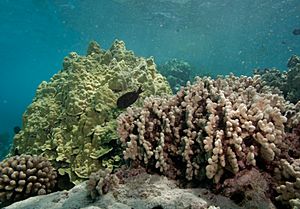Porites compressa facts for kids
Quick facts for kids Porites compressa |
|
|---|---|
 |
|
| Left-to-right: Pocillopora meandrina, Porites lobata, Porites compressa | |
| Conservation status | |
| Scientific classification |
Porites compressa, often called finger coral or hump coral, is a type of hard coral that lives in the ocean. You can find it growing on coral reefs and in shallow, calm parts of the Indian and Pacific Oceans. It's an important part of these amazing underwater worlds.
What is Finger Coral?
Porites compressa usually looks pale brown or gray. If you see it in shallow water, it might look like a bumpy rock. But in deeper water, it grows taller, like columns. Its branches are round and often grow together, forming a solid shape.
This coral grows slowly, but it can form huge colonies. Some of these coral groups can be over 1,000 years old! Porites compressa is a "zooxanthellate" coral. This means it has tiny, helpful algae called zooxanthellae living inside its tissues. These algae are like little power plants, making energy for the coral using sunlight. It's a special partnership!
Where Does Finger Coral Live?
You can find Porites compressa in many warm ocean areas. It lives across the Indo-Pacific region, in the Red Sea, and along the East African coast. It's very common around Hawaii. There, it grows on reefs and in calm, shallow lagoons, sometimes as deep as 30 meters (about 100 feet).
In places like Kaneohe Bay in Hawaii, Porites compressa is the most common coral. Sometimes, it even forms large areas where it's the only type of coral growing.
Dangers to Finger Coral
Porites compressa can be affected by warming ocean temperatures. While it's better at handling coral bleaching than some other corals, it can still get sick. Corals that are stressed are more likely to catch diseases.
Coral reefs around the world face many dangers. These include natural events like El Nino events, which can change ocean conditions. The ocean is also becoming more acidic, which makes it harder for corals to build their skeletons. Fishing activities, like trawling, can damage reefs. Sometimes, new species can move in and compete with corals. Human activities, like pollution and collecting corals for home aquariums, also put reefs at risk. Protecting these incredible underwater cities is very important!


